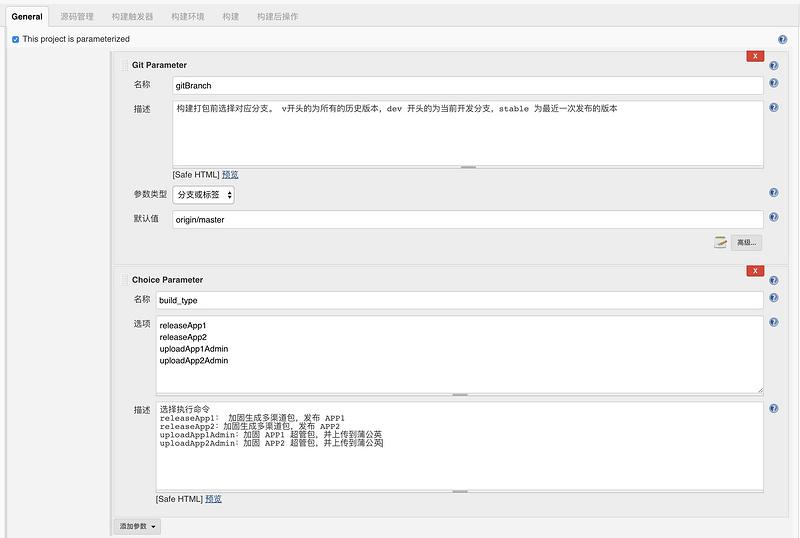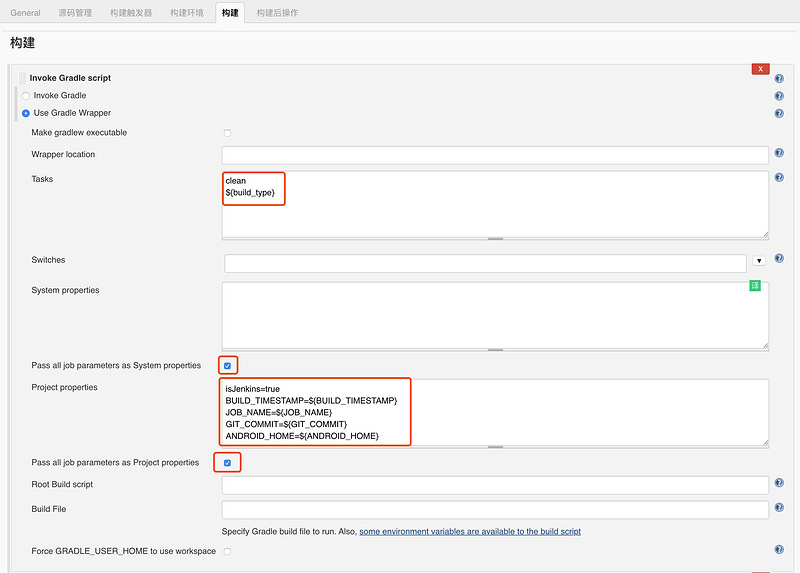提升效率——配置 Jenkins 自动加固签名多渠道包
前两篇文章将我们的打包加固和上传内测平台进行了自动化,节省了开发人员的时间。
但是还有一些问题并没有解决,比如我们正在吭哧吭哧的写代码,测试突然来让你给他打个包,必须要暂停当前的工作,去对应分支执行打包命令,打包期间也只能等着,不能继续写代码。
这时,Jenkins 服务器就派上用场了,我们可以将打包命令在 Jenkins 服务器进行配置,让测试人员自己去选择想要的分支版本进行打包,同时提升双方的效率。
Jenkins 相关的知识网上有很多文章,请大家自行搜索了解,本文只讲解在 Jenkins 上配置以下几点内容:
- 使用梆梆加固命令行加固
- 对加固后的包进行签名
- 使用 VasDolly 进行快速多渠道打包
- 上传安装包到蒲公英
配置 Gradle 脚本
由于将 360 加固替换为梆梆加固,而梆梆加固的命令行工具不支持自动签名和本地多渠道包生成,所以增加了重新签名和 VasDolly 多渠道打包的命令。
加固脚本
完整的 config.gradle 配置:
ext {
curGitCommit = rootProject.properties['GIT_COMMIT'] == null ? getGitCommit() : rootProject.properties['GIT_COMMIT']
curTime = rootProject.properties["BUILD_TIMESTAMP"] == null ? getCurTime() : rootProject.properties["BUILD_TIMESTAMP"]
backupPath = "../buildBackup/"
if (rootProject.properties["isJenkins"].toBoolean()) {
androidHome = rootProject.properties['ANDROID_HOME']
} else {
Properties properties = new Properties()
properties.load(project.rootProject.file('local.properties').newDataInputStream())
androidHome = properties.getProperty('sdk.dir')
}
//签名文件配置
signing = [keyAlias : 'xxxxx',
keyPassword : 'xxxxx',
storeFile : '../sign.keystore',
storePassword: 'xxxxxx']
//蒲公英配置
pgy = [apiKey : "xxxx",
uploadUrl: "https://www.pgyer.com/apiv2/app/upload"]
//加固配置
jiagu = [
app1Online : "${backupPath}${curGitCommit}/${curTime}/app1Online_jiagu/",
app1Admin : "${backupPath}${curGitCommit}/${curTime}/app1Admin_jiagu/",
app2Online : "${backupPath}${curGitCommit}/${curTime}/app2Online_jiagu/",
app2Admin : "${backupPath}${curGitCommit}/${curTime}/app2Admin_jiagu/",
channelConfigPath: '../jiagu/Channel.txt',
VasDollyJar : "../jiagu/VasDolly.jar",
banbanJar : "../jiagu/secapi.jar",
banbanName : rootProject.properties['banbanName'] == null ? "banbanName" : rootProject.properties['banbanName'],
banbanApiKey : rootProject.properties['banbanApiKey'] == null ? "banbanApiKey" : rootProject.properties['banbanApiKey'],
banbanSecretKey : rootProject.properties['banbanSecretKey'] == null ? "banbanSecretKey" : rootProject.properties['banbanSecretKey'],
banbanIp : rootProject.properties['banbanIp'] == null ? "banbanIp" : rootProject.properties['banbanIp'],
]
android = [compileSdkVersion: 28,
buildToolsVersion: "29.0.3",
minSdkVersion : 19,
targetSdkVersion : 28]
apksignerDir = "${androidHome}/build-tools/${android['buildToolsVersion']}/"
//版本号管理
APP1_VERSION_NAME = "2.0.2"
APP1_TEST_NUM = "0001"
APP2_VERSION_NAME = "1.0.5"
APP2_TEST_NUM = "0005"
dependencies = [
"androidx-appcompat" : "androidx.appcompat:appcompat:1.1.0",
"androidx-constraintlayout": "androidx.constraintlayout:constraintlayout:1.1.3",
"VasDolly-helper" : "com.leon.channel:helper:2.0.3",
]
}
static def getCurTime() {
return new Date().format("yyyy-MM-dd_HH-mm-ss")
}
static def getGitCommit() {
def exceptionStr = "git rev-parse HEAD 执行失败"
try {
def cmd = 'git rev-parse HEAD'
def gitCommit = cmd.execute().text.trim()
if (gitCommit.isEmpty()) {
throw new GradleException(exceptionStr)
}
return gitCommit
} catch (Exception e) {
throw new GradleException(exceptionStr, e)
}
}
在 jiagu.gradle 中实现加固签名和多渠道包逻辑:
import org.apache.tools.ant.taskdefs.condition.Os
/**
* 加固
* @param config 配置加固策略
* @param apkPath 要加固的文件路径
* @param outputPath 输出路径
* @param channelName 渠道名,为 Null 时读取 rootProject.ext.jiagu["channelConfigPath"] 多渠道配置文件
*/
def jiaGu(String config, String apkPath, String outputPath, String channelName) {
println("开始加固 /nconfig:$config /napkPath:$apkPath /noutputPath:$outputPath /nchannelName:$channelName")
exec {
executable = 'java'
args = ['-jar', rootProject.ext.jiagu["banbanJar"],
'-i', rootProject.ext.jiagu["banbanIp"],
'-u', rootProject.ext.jiagu["banbanName"],
'-a', rootProject.ext.jiagu["banbanApiKey"],
'-c', rootProject.ext.jiagu["banbanSecretKey"],
'-f', '0',
'-t', config,
'-p', apkPath,
'-d', outputPath,
]
}
println "加固的文件路径:${apkPath}"
println "加固后的文件路径:${outputPath}"
def signApkPath = apkSigner(outputPath)
generatingMultipleChannels(signApkPath, outputPath, channelName)
//在 Jenkins 上运行时,将构建产物备份到硬盘根目录,
if (isJenkins.toBoolean()) {
String sourceDir = file(outputPath).parentFile.absolutePath
String destinationDir = "/Users/buildBackup/${rootProject.properties["JOB_NAME"]}/${rootProject.ext.curGitCommit}/${rootProject.ext.curTime}/"
new groovy.util.AntBuilder().copy(todir: destinationDir) {
fileset(dir: sourceDir)
}
println "将构建产物备份到:${destinationDir}"
}
}
def apkSigner(String apkDir) {
def apkFile = getApkFile(apkDir)
if (apkFile == null || !apkFile.exists()) {
throw GradleException("加固后的 apk 文件不存在")
}
def signDir = new File(apkDir, 'sign')
if (!signDir.exists()) {
signDir.mkdirs()
}
def outputApkPath = new File(signDir, apkFile.name)
def storeFile = rootProject.ext.signing["storeFile"]
def storeFilePath = file(storeFile).absolutePath
//兼容 Windows、Mac、Linux 系统
def execuTable = Os.isFamily(Os.FAMILY_WINDOWS) ? 'cmd' : 'sh'
def apksigner = Os.isFamily(Os.FAMILY_WINDOWS) ? 'apksigner.bat' : './apksigner'
println("对加固包进行签名")
def parameter = [apksigner, 'sign',
'--ks', storeFilePath,
'--ks-key-alias', rootProject.ext.signing["keyAlias"],
'--ks-pass', "pass:${rootProject.ext.signing["storePassword"]}",
'--key-pass', "pass:${rootProject.ext.signing["keyPassword"]}",
'--out', outputApkPath, apkFile.absolutePath]
if (Os.isFamily(Os.FAMILY_WINDOWS)) {
parameter.add(0, '/c')
}
exec {
workingDir = rootProject.ext.apksignerDir
executable = execuTable
args = parameter
}
println "apk 签名成功:" + outputApkPath
return outputApkPath
}
/**
* 生成多渠道包
* @param signApkPath 基准包
* @param outputDir 输出目录
* @param channelName 渠道名,为 Null 时读取 rootProject.ext.jiagu["channelConfigPath"] 多渠道配置文件
*/
private void generatingMultipleChannels(signApkPath, outputDir, channelName) {
def channelDir = new File(outputDir, 'channels')
if (!channelDir.exists()) {
channelDir.mkdirs()
}
println("生成多渠道包")
def channel = channelName == null ? rootProject.ext.jiagu["channelConfigPath"] : channelName
exec {
executable = 'java'
args = ['-jar', rootProject.ext.jiagu["VasDollyJar"],
'put', '-c', channel,
signApkPath, channelDir.absolutePath
]
}
println("生成多渠道包完毕")
}
def getApkPath(String flavor) {
if ("app1Online" == flavor) {
return "${projectDir.absolutePath}/build/outputs/apk/production/release/${getApkName(rootProject.ext.android["versionName"])}"
} else {
return "${projectDir.absolutePath}/build/outputs/apk/${flavor}/release/${getApkName(getTestVersionName(flavor))}"
}
}
private def getApkFile(String fileDir) {
def dir = file(fileDir)
if (!dir.exists()) {
println "dir not exists:" + dir.path
return null
}
File[] files = dir.listFiles(new FileFilter() {
@Override
boolean accept(File file) {
return file.isFile() && file.name.endsWith(".apk")
}
})
if (files == null || files.size() == 0) {
println "files == null || files.size() == 0"
return null
}
return files[0]
}
private static void checkOutputDir(File apkOutputFile) {
if (apkOutputFile.exists()) {
File[] files = apkOutputFile.listFiles()
if (files != null) {
for (File file : files) {
file.delete()
}
}
} else {
apkOutputFile.mkdirs()
}
}
/**
* App1
* 根据多渠道文件进行加固
* 执行命令:./gradlew releaseApp1
*/
task releaseApp1(dependsOn: ['assembleApp1OnlineRelease']) {
group = "publish"
doLast {
def apkOutputFile = file(rootProject.ext.jiagu["app1OnlineOutputPath"])
checkOutPutDir(apkOutputFile)
def apkFile = file(getApkPath("App1Online"))
if (!apkFile.exists()) {
println("apk file is not exists:" + apkFile.absolutePath)
return
}
jiaGu("1", apkFile.absolutePath, apkOutputFile.absolutePath, null)
}
}
我们只需要在命令行执行 ./gradlew releaseApp1 就会执行编译—>加固—>签名—>生成多渠道包
上传蒲公英的代码和前文一样,只需要改动一下 apk 路径,取生成的渠道包进行上传。
Jenkins 配置
首先我们创建好任务,配置 task 命令参数:

再配置 Gradle 插件执行上面选择的命令,并配置 Project properties:

如果执行上传蒲公英的任务,我们希望直接显示蒲公英的二维码,增加如下 Set build description 配置:

我们保存配置,执行任务:
 执行成功后的效果:
执行成功后的效果:

总结
全文没有做太多讲解,直接上代码上配置图片,简单粗暴,如果 Gradle 部分有疑惑的建议看看前面几篇文章。
对于 Jenkins 的配置本文只是一笔带过,相信大家简单了解一下相关的概念和原理就能快速上手,基本流程跑通以后可以举一反三实现更多功能。
最后上 demo 地址: https://github.com/imliujun/G...
- 本文标签: API 二维码 root http 自动化 id 安装 App 开发 测试 Property https 管理 list apache ask db 希望 cat 时间 dependencies 编译 Job git IDE key java src windows IO description 代码 参数 服务器 文章 ip tk UI parse 目录 build cmd 图片 tar GitHub 插件 备份 Word jenkins stream 配置 Android linux 总结 tab ORM
- 版权声明: 本文为互联网转载文章,出处已在文章中说明(部分除外)。如果侵权,请联系本站长删除,谢谢。
- 本文海报: 生成海报一 生成海报二










![[HBLOG]公众号](https://www.liuhaihua.cn/img/qrcode_gzh.jpg)

